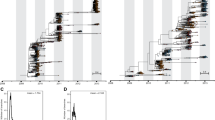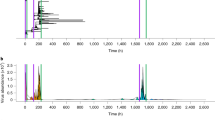Abstract
ATYPICAL protein antigen contains several epitopes that can be recognized by cytotoxic T lymphocytes (CTL), but in a characteristic antiviral immune response in vivo, CTL recognize only a small number of these potential epitopes, sometimes only one1–2, this phenomenon is known as immunodominance1–10. Antigenic variation within CTL epitopes has been demonstrated for the human immunodeficiency virus HIV-1 (ref. 11) and other viruses12–7 and such 'antigenic escape' may be responsible for viral persistence. Here we develop a new mathematical model that deals with the interaction between CTL and multiple epitopes of a genetically variable pathogen, and show that the nonlinear competition among CTL responses against different epitopes can explain immunodominance. This model suggests that an antigenically homogeneous pathogen population tends to induce a dominant response against a single epitope, whereas a heterogeneous pathogen population can stimulate complicated fluctuating responses against multiple epitopes. Antigenic variation in the immunodominant epitope can shift responses to weaker epitopes and thereby reduce immuno-logical control of the pathogen population. These ideas are consistent with detailed longitudinal studies of CTL responses in HIV-1 infected patients. For vaccine design, the model suggests that the major response should be directed against conserved epitopes even if they are subdominant.
This is a preview of subscription content, access via your institution
Access options
Subscribe to this journal
Receive 51 print issues and online access
$199.00 per year
only $3.90 per issue
Buy this article
- Purchase on Springer Link
- Instant access to full article PDF
Prices may be subject to local taxes which are calculated during checkout
Similar content being viewed by others
References
Hill, A. B. et al. Immun. Rev. 133, 75–91 (1993).
Townsend, A. & Bodmer, H. A. Rev. Immun. 7, 601–633 (1989).
Adorini, L. et al. J. exp. Med. 168, 2091–2104 (1988).
Liu, Z. et al. J. Immun. 151, 1852–1858 (1993).
Sercarz, E. E. et al. A. Rev. Immun. 11, 729–766 (1993).
Buus, S. et al. Science 235, 1353–1358 (1987).
Schaeffer, E. B. et al. Proc. natn. Acad. Sci. U.S.A. 86, 4649–4653 (1989).
Zinkernagel, R. M. et al. J. exp. Med. 148, 592–606 (1978).
Takahashi, H. et al. Science 246, 118–121 (1989).
Gegin, C. & Lehmann-Grube, F. J. Immun. 149, 3331–3338 (1992).
Phillips, R. E. et al. Nature 354, 453–459 (1991).
Aebischer, T. et al. Proc. natn. Acad. Sci. U.S.A. 88, 11047–11051 (1991).
Klenerman, P. et al. Nature 369, 403–407 (1994).
Niewiesk, S. et al. J. Virol. 69, 2649–2653 (1995).
Campos-Lima, P. et al. Science 260, 98–100 (1993).
Bertoletti, A. et al. Nature 369, 407–410 (1994).
Moskophidids, D. & Zinkernagel, R. M. J. Virol. 69, 2187–2193 (1995).
Nixon, D. F. et al. Nature 336, 484–487 (1988).
Walker, B. D. Science 240, 64–66 (1988).
McMichael, A. J. & Walker, B. D. AIDS 8, S155–S174 (1994).
Koup, R. A. et al. J. Virol. 68, 4650–4655 (1994).
Safrit, J. T. et al. J. exp. Med. 179, 463–472 (1994).
Pantaleo, G. et al. Nature 370, 463–467 (1994).
Nowak, M. A., May, R. M., Sigmund, K. J. theor. Biol. (in the press).
Bangham, C. R. M. & McMichael, A. J. in T-cell Immunity to Viruses in T Cells (eds Feldmann, M., Lamb, J., Owen, M. J.) 281–310 (Wiley, New York, 1989).
Carpenter, S. in Applied Virology Research 2. Virus Variability, Epidemiology, and control (eds Kurstak, E., Marusyk, R. G., Murphy, F. A. & van Regenmortel, H. V.) 99–115 (Plenum Medical Book Company, New York and London, 1990).
Nowak, M. A. et al. Science 254, 963–969 (1991).
Nowak, M. A. & May, R. M. AIDS 7 (suppl. 1), S3–S18 (1993).
Author information
Authors and Affiliations
Rights and permissions
About this article
Cite this article
Nowak, M., May, R., Phillips, R. et al. Antigenic oscillations and shifting immunodominance in HIV-1 infections. Nature 375, 606–611 (1995). https://doi.org/10.1038/375606a0
Received:
Accepted:
Issue Date:
DOI: https://doi.org/10.1038/375606a0
This article is cited by
-
Competitive dual-strain SIS epidemiological models with awareness programs in heterogeneous networks: two modeling approaches
Journal of Mathematical Biology (2023)
-
HBV quasispecies composition in Lamivudine-failed chronic hepatitis B patients and its influence on virological response to Tenofovir-based rescue therapy
Scientific Reports (2017)
-
Modeling T cell responses to antigenic challenge
Journal of Pharmacokinetics and Pharmacodynamics (2014)
-
Bifurcation, stability, and cluster formation of multi-strain infection models
Journal of Mathematical Biology (2013)
-
Evolutionary dynamics of HIV at multiple spatial and temporal scales
Journal of Molecular Medicine (2012)
Comments
By submitting a comment you agree to abide by our Terms and Community Guidelines. If you find something abusive or that does not comply with our terms or guidelines please flag it as inappropriate.



